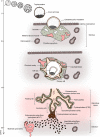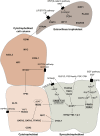Transcription factor networks in trophoblast development
- PMID: 35657505
- PMCID: PMC9166831
- DOI: 10.1007/s00018-022-04363-6
Transcription factor networks in trophoblast development
Abstract
The placenta sustains embryonic development and is critical for a successful pregnancy outcome. It provides the site of exchange between the mother and the embryo, has immunological functions and is a vital endocrine organ. To perform these diverse roles, the placenta comprises highly specialized trophoblast cell types, including syncytiotrophoblast and extravillous trophoblast. The coordinated actions of transcription factors (TFs) regulate their emergence during development, subsequent specialization, and identity. These TFs integrate diverse signaling cues, form TF networks, associate with chromatin remodeling and modifying factors, and collectively determine the cell type-specific characteristics. Here, we summarize the general properties of TFs, provide an overview of TFs involved in the development and function of the human trophoblast, and address similarities and differences to their murine orthologs. In addition, we discuss how the recent establishment of human in vitro models combined with -omics approaches propel our knowledge and transform the human trophoblast field.
Keywords: Human placenta; Human trophoblast stem cells; Transcription factors; Trophoblast.
© 2022. The Author(s).
Conflict of interest statement
The authors declare no conflict of interest.
Figures




References
-
- Boyd JD, Hamilton WJ. The human placenta. Cambridge (England) Heffer. London: Palgrave Macmillan; 1970.
Publication types
MeSH terms
Substances
Grants and funding
LinkOut - more resources
Full Text Sources
Miscellaneous

